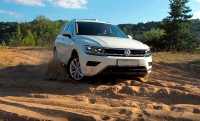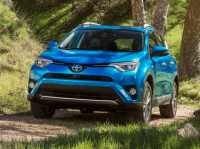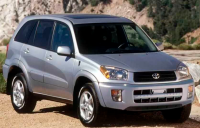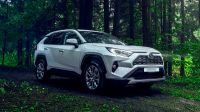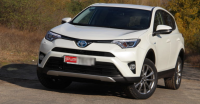Volkswagen Tiguan or Toyota Rav 4 - which would you buy? Many readers may already have the answer to this question. But wait! If you haven't had a chance to get a closer look at these cars before, chances are you'll change your mind after reading this. We begin our detailed review of crossovers that need no introduction: volkswagen tiguan vs toyota rav4.
Japanese
The appearance of the Rav 4 has long been the talk of the town. Since 2013, when the appearance of the model was completely redesigned - frankly, we have a completely different car in front of us. Enough time has passed and everyone has got used to the new look.
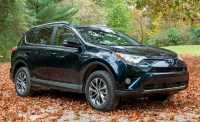 The 2016 Rav 4, which is a restyled version of the last generation, has been given a more harmonious and attractive design. Overall, the crossover is interesting and slightly aggressive.
The 2016 Rav 4, which is a restyled version of the last generation, has been given a more harmonious and attractive design. Overall, the crossover is interesting and slightly aggressive.
The sharp and narrow lines of the false grille, flowing seamlessly into the equally pointed headlamps, slightly resemble an eagle's eye. Incidentally, some observers find something in common between the front of the Toyota Rav 4 and the Stormtrooper mask from Star Wars.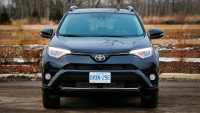 Compared to the 2014 Rav 4, the design of the new model has changed for the better: the lines have become more organic, the feminine look has almost disappeared, and the geometry of the doors and stern has changed. However, it still fails to excite.
Compared to the 2014 Rav 4, the design of the new model has changed for the better: the lines have become more organic, the feminine look has almost disappeared, and the geometry of the doors and stern has changed. However, it still fails to excite.
The German
Before we start parsing the new Tiguan, it's worth noting that VW launched a large-scale and rather bold advertising campaign a year before the model's release. Marketers claimed that the 2017 Tiguan would make a breakthrough among crossovers and would confidently put all competitors, including the Kia and Rav4, under its belt. Therefore, it is our duty not only to compare the two models, but also to determine whether the new German has become a model for all crossovers.
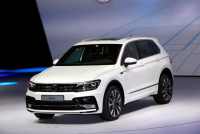 For a start, it's worth noting that the proportions of the new car have changed compared to the 2014 Volkswagen Tiguan. The wheelbase has increased by 77 mm, it is 60 mm longer, wider and slightly lower. This has had a significant impact on the visual perception of the car.
For a start, it's worth noting that the proportions of the new car have changed compared to the 2014 Volkswagen Tiguan. The wheelbase has increased by 77 mm, it is 60 mm longer, wider and slightly lower. This has had a significant impact on the visual perception of the car.
Whereas the previous generation seemed square, elevated above the road and even slightly flattened on the sides, the new 2017 Tiguan is definitely more attractive. There is balance in its proportions and it looks fully established.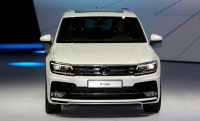 The body lines of the new VW are sharper. There are more angles in the design and fewer smooth and rounded elements. Although absolutely all parts of the body have changed - bumpers, doors, headlights, bonnet, boot, window geometry - it remains recognisable. When you see it on the street, everyone knows it's a Tiguan.
The body lines of the new VW are sharper. There are more angles in the design and fewer smooth and rounded elements. Although absolutely all parts of the body have changed - bumpers, doors, headlights, bonnet, boot, window geometry - it remains recognisable. When you see it on the street, everyone knows it's a Tiguan.
R16, R17 and R18 wheels are available for the driver's choice, depending on equipment. Xenon is no longer available in any form. The basic configuration is equipped with halogen headlights, and all the more expensive ones with LED optics. And in Tiguan there are two variants of LED: budget and expensive. The difference lies in the quality and brightness of the light.
Who's prettier?
When deciding which is better in terms of looks, many people will probably opt for the Volkswagen. It is objectively more attractive, more organic and looks complete. Design of Rav 4 looks more like an unfinished experiment. The Japanese crossover is not bought for its looks, though.
A look from the inside
Quality
In the interior of the 2017 Volkswagen Tiguan, you'll see the same qualities as in the exterior - style, high quality materials, elegant and sleek lines. Looking at the details, it's clear that the company has done a lot of work. From the position of the driver's seat, it seems that you will not find an area that has been made "hastily". Manufacturers did not try to "cheapen" the car, economizing on materials in hard-to-reach places or inserting the first found buttons into invisible to eyes areas. Every centimetre has been thought out in detail.
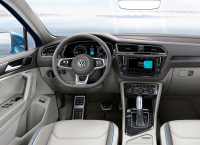 The Toyota Rav 4 is inferior to its rival in this respect. The buttons in different parts of the car are different, and the combination of materials is rather controversial. It would seem that the crossover is of an executive class, but the front panel looks somehow budget. Probably it is a mistake of designers who were too carried away with experiments.
The Toyota Rav 4 is inferior to its rival in this respect. The buttons in different parts of the car are different, and the combination of materials is rather controversial. It would seem that the crossover is of an executive class, but the front panel looks somehow budget. Probably it is a mistake of designers who were too carried away with experiments.
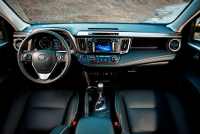 Options
Options
In the Japanese's defence, the 2017 Rav 4 has very comfortable seats. This applies to both the first and second rows. The seats and sofa are made of leather, which is not the case in the $2 million Tiguan.
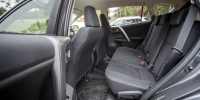 The Toyota comes with a complete winter package and a host of options to help the driver. These include all-around visibility, adaptive cruise control, blind spot monitoring and lane-keeping systems.
The Toyota comes with a complete winter package and a host of options to help the driver. These include all-around visibility, adaptive cruise control, blind spot monitoring and lane-keeping systems.
 However, the competitor is not inferior in the number of options. In addition to the set of systems already listed, the owners of VW Tiguan get the possibility of individual adjustment of driving parameters for their money. The on-board computer can contain several accounts, each with personal driving settings.
However, the competitor is not inferior in the number of options. In addition to the set of systems already listed, the owners of VW Tiguan get the possibility of individual adjustment of driving parameters for their money. The on-board computer can contain several accounts, each with personal driving settings.
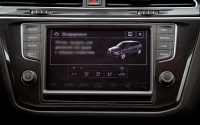 A handy option if more than one person is using the vehicle. When you switch to your account, the computer automatically adjusts the seat position, driving mode, suspension settings and dashboard settings left in memory from the last time you used the vehicle.
A handy option if more than one person is using the vehicle. When you switch to your account, the computer automatically adjusts the seat position, driving mode, suspension settings and dashboard settings left in memory from the last time you used the vehicle.
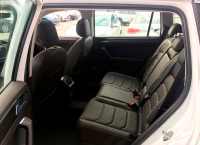 But the German also has disadvantages. Obviously, the car was designed for clean European roads, but crossovers assembled in Kaluga enter the Russian market. So why was the location of the front camera which was placed under the number plate unchanged? It will become useless after a couple of minutes on a wet off-season road. The same goes for the parking sensors. There are quite a few, by the way. But some of them are planted too low. And because the systems are designed to signal a possible obstacle, prepare to have the dirty sensors regularly and methodically piss you off without realising what's going on around you.
But the German also has disadvantages. Obviously, the car was designed for clean European roads, but crossovers assembled in Kaluga enter the Russian market. So why was the location of the front camera which was placed under the number plate unchanged? It will become useless after a couple of minutes on a wet off-season road. The same goes for the parking sensors. There are quite a few, by the way. But some of them are planted too low. And because the systems are designed to signal a possible obstacle, prepare to have the dirty sensors regularly and methodically piss you off without realising what's going on around you.
Boot
Boot comparison also led to the Volkswagen Tiguan's victory: 615 litres versus 577 litres. According to the company's specialist, the new German crossover should outshine all its competitors. However, opening the electric boot in VW, you don't feel the "wow effect". You get the impression that the claimed 615 litres are not there and you have been cheated. And when you understand that back seats move on skids, you have an impression that volume of a luggage compartment has been calculated with seats of the second row moved in as much as possible. But then you can forget about passenger seating in principle!
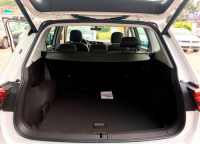 What the new Rav 4 is really inimitable about is the loading height and the amount of space in the back seat. Incidentally, Toyota has a full-size wheel under the boot floor, while the rival has just a spare wheel.
What the new Rav 4 is really inimitable about is the loading height and the amount of space in the back seat. Incidentally, Toyota has a full-size wheel under the boot floor, while the rival has just a spare wheel.
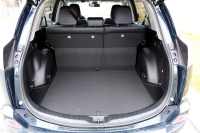 Is it a crossover?
Is it a crossover?
In order to determine which car is better when comparing crossovers, you need to check their driving characteristics. Toyota's suspension has always been tough. This was true of the 2010 Rav 4 as well as the already new generation that came out in 2013-2014. The restyled version has become much softer. Engineers have made significant adjustments to the design, and it's noticeable! The new Rav 4 is more comfortable on rough terrain, but it falls short of the 2016-2017 Tiguan.
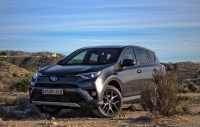 The competitor swallows all bumps with ease and moves at a confident speed over rough terrain. The comfort of the second row is especially noteworthy - the Tiguan's rear seat passengers are not afraid of any bumps.
The competitor swallows all bumps with ease and moves at a confident speed over rough terrain. The comfort of the second row is especially noteworthy - the Tiguan's rear seat passengers are not afraid of any bumps.
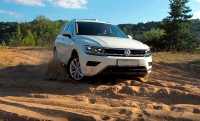 The handling ability of both cars is roughly the same! However, a detailed comparison reveals that the Toyota is more suitable for off-roading. In addition, the RAV 4 has quite sharp and precise steering, which is a little lacking in the opponent.
The handling ability of both cars is roughly the same! However, a detailed comparison reveals that the Toyota is more suitable for off-roading. In addition, the RAV 4 has quite sharp and precise steering, which is a little lacking in the opponent.
Owners of Volkswagen can be embarrassed only by 2 things: absence of steering sharpness and DSG gearbox. However, according to Volkswagen's expert, the DQ500 robotised gearbox is the best DSG automatic transmission available at the moment, so there is no need to doubt its reliability.
Features and prices
Tiguan
Volkswagen Tiguan offers customers 5 engine options:
1.4 litre petrol with 125 hp (6MSG or 6DSG transmission type available);
Gasoline 1.4 liter 150 hp (6DSG only);
Gasoline 2.0 litre, 180 hp (7-speed DSG);
Gasoline 2.0 litre, 220 PS (7-speed DSG);
Diesel 2.0 litre, 150 hp (7-speed DSG).
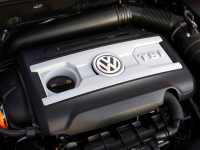 However, 125bhp models come exclusively with front-wheel drive. Buyers of the 150bhp petrol engine have a choice of 4×2 or 4×4 formulas. All other modifications are sold with all-wheel drive.
However, 125bhp models come exclusively with front-wheel drive. Buyers of the 150bhp petrol engine have a choice of 4×2 or 4×4 formulas. All other modifications are sold with all-wheel drive.
The cost of the new crossover begins from 20 300 dollars. And the maximum configuration Highline with 2-liter petrol engine will cost 33 000 dollars. The diesel engine in the same configuration costs from 30 300 dollars.
Rav 4
The Toyota Rav4 offers customers three engine types:
2.0 litre petrol engine. (146 hp);
2.2 litre diesel (150 hp);
2.5 litre (180 hp) petrol engine.
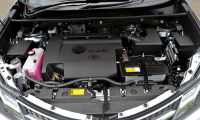 The two-litre engine is available with either a six-speed manual or a variator. This variant comes with front-wheel drive and all-wheel drive. The other engines have a 6ACRP and all-wheel drive only. Prices as of 2018 start from 21 700 USD and reach $ 33 200 depending on the configuration. A model with a diesel engine of the same power as the Tiguan (150 hp), in the maximum "Prestige" configuration costs 32 500 dollars.
The two-litre engine is available with either a six-speed manual or a variator. This variant comes with front-wheel drive and all-wheel drive. The other engines have a 6ACRP and all-wheel drive only. Prices as of 2018 start from 21 700 USD and reach $ 33 200 depending on the configuration. A model with a diesel engine of the same power as the Tiguan (150 hp), in the maximum "Prestige" configuration costs 32 500 dollars.
When choosing what to buy, the key argument for many is price, and in this case the Tiguan is the clear winner on every point.
Which is better to take?
Some might have thought that the VW would cost an order of magnitude more than its rival, as it does outperform the Rav 4 on a number of parameters. However, its cost turned out to be lower. But it's worth noting that the Tiguan hasn't made a giant breakthrough, as marketers have assured. And in this sense, the automobile, perhaps, has not justified someone's hopes. Nevertheless, Tiguan is undoubtedly a quality car made for people!
When deciding what to choose - Volkswagen or Toyota - it is logical that preference should be given to the German concern. Their crossover is more pleasant, more technologically and is much more qualitatively assembled. And the main thing is that it is cheaper!
But Toyota has unfathomable magic! No matter what, people buy, buy and will buy the Rav 4! This brand in Russia has a large number of fans who appreciate it for reliability, low maintenance costs and reputation earned over the years. This "magic" can hardly be broken. Year after year, though, talented newcomers emerge, eager to push the Japanese crossover from the top of the automotive Olympus. Perhaps the new Tiguan will succeed.
